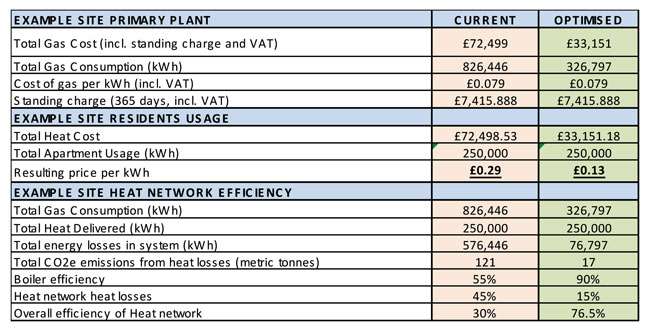by Helen Näslund, Technical Specification Manager, Evinox Energy Ltd
We are all bracing ourselves for this upcoming winter and are all expecting to feel the pinch of the cost of living crisis. Food prices, interest rates and not least energy costs are soaring. On the news there has been talk of potential energy black outs this winter and there have been articles in papers where councils are saying they might need to turn their communal heating systems off for up to five hours a day to keep costs down, leaving their residents in the cold.

Over the last few months several measures have been put in place to try lessen the blow for the British public, for example the energy price cap not covering communal heating system, what is and can actually be done in this area?
Regardless of what financial help the government is putting in place to protect residents served by communal heat networks, the reality is that the one thing that should be done is ensuring that all current heat networks are operating to their full potential and not unnecessarily wasting vast amounts of energy. Reducing the overall energy consumption of heat networks will significantly help with reducing the tenants energy bills and reduce greenhouse gas emissions and crucially help safeguard Britain’s energy security this winter.
The majority of the 18,000 plus heat networks in the UK are running at a very poor efficiency level, often at 30% overall efficiency or less. And in this case, whilst only 30% of the energy used by the central boiler ends up being delivered to the residents, it is still the residents picking up the full gas bill and we see 70% of the primary energy used wasted and quite literally disappearing into thin air. As a simple example, in the table below I have tried to illustrate the difference it will make having an efficiently operating heat network versus a low efficiency network, which is currently commonplace.

In both examples here, the residents’ total usage over the course of a year is 250,000 kWh, but in the first column the primary boiler require 826,446 kWh worth of gas to be able to meet the residents demand, whereas in the optimised example only 326,797 kWh of gas is needed. The energy tariff required in the optimised heat network would be 13 pence per kWh, whereas the tariff of a typical current situation heat network would need to be 29 pence! What this will mean to the tenant is that they can save on average just under £400 per year in energy costs, and your communal heat network will be emitting 104 tonnes less CO2e.

It’s important to add that these calculations have been done with recent pricing levels in mind, going back only a few months a kWh of commercial gas would typically be purchased at 3p, compared with the 8p per kWh used in the worked example, and we have more recently seen clients with gas bills at much higher unit rates at much higher levels than this.
Nearly all communal heat networks have the potential to achieve a much higher efficiency level than they are currently running at with less work required than you might think. It is often easy fixes that can be carried out in under an hour per apartment and even with the cost of doing the work accounted for, the tenants will still end up being several hundred pounds better off per year.
The example mentioned above where a local council is resorting to turning the communal eating system off for five hours per day shows that there is a lack of understanding of communal heating systems, how they work, and what makes them perform efficiently etc. The first course of action should not be to turn the heating off, and especially not if serving elderly or vulnerable tenants. This lack of understanding is most likely not due to ignorance, but much more likely a result of lack of resource and time within Local Authorities. But it goes to show that the power to protect tenants against rocketing heat prices is in the hands of Local Authorities and Housing Associations.

There are several risk factors associated with not preventing this energy wastage. First of all, you would be running the risk of residents not being able to afford their bills, which would affect the wellbeing of the local community as well as your bill collection rates and cash flow. There is also a risk of electricity becoming more affordable than heat, in which case the residents realise that it would be cheaper to buy electric heaters and use these instead of using their central heating system.
The first step needs to be an efficiency overhaul of the heat network, this is the main thing that will protect your tenants from excessive bills this winter. But there will also be government support available to help further. Things are changing fast at the moment, but at the time of writing this the following support is available:
• Energy Bill Relief Scheme (EBRS) – this scheme will run from the 1st October 2022 to the 31st March 2023 and offers relief for commercial rate customers on certain contracts. The government will provide a discount so that the wholesale price is limited to £75 per MWh for gas and £211 per MWh for electricity, but there will be a maximum discount available of £91 for gas and £345 for electricity per MWh, so if the wholesale prices exceed this then bills can continue to rise. But please note that this discount only applies to the wholesale element of your gas or electricity bill.
• Energy Bills Support Scheme (EBSS) – This is £400 payment which will be paid to all households in Britain to help with the rising energy bills, and will be paid in 6 monthly instalments starting in October 2022. This payment will be handled by the electricity provider, so residents connected to heat networks will still receive this payment, unless they are on a private wire network in which case it will be administered differently. In addition to this £400 payment, households in England which are in council tax bands A-D will also receive a £150 rebate administered through the local authority.
• Energy Price Guarantee (EPG) – whilst tenants served by heat networks will not benefit from the domestic gas rate price cap, they will still benefit from the price cap on electricity. But there has also been a statement made by the government saying “Those households who do not pay direct for mains gas and electricity – such as those living in park homes or on heat networks – will be no worse off and receive support through a new fund.”

The reason there is no current price cap on heat is because heat networks are not covered by Ofgem, as Ofgem currently only regulates gas and electricity markets. It has however recently been announced that Ofgem will be appointed regulators of the Heat Networks sector. With this Ofgem will be given new powers to regulate prices in this sector as a matter of priority. It is also proposed that Ofgem will be given powers to investigate and intervene where prices for consumers appear to be disproportionate compared with similar systems, or if prices are significantly higher than those consumers would expect to pay if they were served by an alternative heating system.
At Evinox Energy, we have done several site surveys to assess poor performing heat networks, and with our experienced engineers we can often quickly identify the main contributors and suggest actions that can be taken to improve the performance and put in place a monitoring system to help ensure the efficiency stay at the higher level for years to come once work has been carried out. The work which would typically be required will be at a lot lower cost than you probably think.
If you have communal heating systems in your portfolio that you suspect might be under-performing, please get in touch with us for more information on how we can help reduce the cost of operating the network, and most importantly ensure the lowest possible tariff for your tenants.
www.evinoxenergy.co.uk
sales@evinox.co.uk
- Log in to post comments













